No Results Found
The page you requested could not be found. Try refining your search, or use the navigation above to locate the post.

# CRM Automation, Sales Productivity, AI in Sales, Digital Transformation, Customer Experience, Future Of Work, SalesTechnology
IT service portals: the key to faster, smarter support
Support teams are under pressure to resolve requests quickly, yet many of those requests are repetitive and time-consuming. An IT service portal gives employees and customers one place to request support, find resources, and track progress. In this article, you’ll learn how IT service portals improve productivity, lower costs, and give employees more control, plus how a platform like monday service makes it easy to launch one with AI-powered automation and no-code customization.
An IT service portal is a digital workspace where employees and customers can access IT resources, request support, and track updates in one place. Instead of relying on manual replies from a helpdesk, people get self-service options that resolve issues quickly.
The goal is twofold: give employees more control over support and shift IT’s focus from routine tickets to higher-value work. Unlike a traditional helpdesk that manages requests one by one, a service portal reduces that dependency with tools like a knowledge base, service catalogue, and automated workflows.
IT teams face growing demands, while employees expect quick answers. A self-service portal supports both needs:
When employees can find answers quickly, ticket volume naturally drops and both IT and employees benefit.
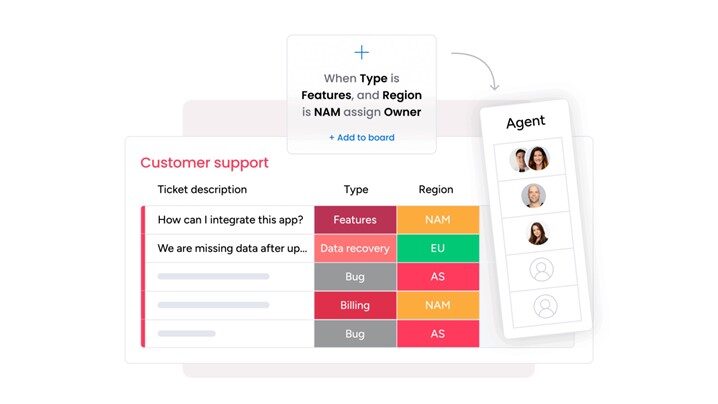
An IT service portal should deliver more than basic ticket logging. The right features drive adoption, make self-service usable, and give IT the visibility to manage requests efficiently. Together, these capabilities create a smoother experience for employees and measurable gains for IT.
A knowledge base is the foundation of self-service. Step-by-step guides, FAQs, and troubleshooting walkthroughs let employees solve routine issues on their own. This reduces wait times and shifts IT’s focus to more strategic projects. To be effective, a knowledge base should be easy to update, searchable, and accessible across devices.
A service catalogue standardizes how employees request access, devices, or software. Instead of sending ad hoc emails, they choose from predefined services with clear descriptions and approval workflows. This consistency helps IT track requests from submission through resolution without unnecessary manual effort.
Some issues still require IT support. A strong portal makes ticket logging simple and transparent, giving employees clear visibility into ownership and progress. Features like automated notifications, ticket history, and SLA tracking strengthen trust and reduce back-and-forth communication.
Search is what makes self-service usable. Employees should be able to quickly find the right resource without sifting through long lists. A modern portal surfaces the most relevant content, whether it’s a guide, a catalogue item, or an open ticket, so users can resolve issues faster.
Automation reduces the manual work that slows IT down. Routing tickets to the right team, sending closure messages, and escalating requests at risk of breaching SLAs all keep requests moving. With fewer routine tasks to manage, IT can dedicate time to innovation and long-term improvements.
Employees sometimes need immediate support. The live chat inside the portal connects them directly with IT for pressing issues, while proactive announcements, such as planned maintenance or outages, help reduce duplicate tickets. With monday service, teams can also push updates directly into Slack channels to keep employees informed without switching tools.
Selecting an IT service portal requires more than a feature checklist. The best option will support your scale, adapt to your processes, and protect sensitive data.
The right portal balances robust functionality with usability, giving IT the control they need while creating a seamless experience employees will use every day.
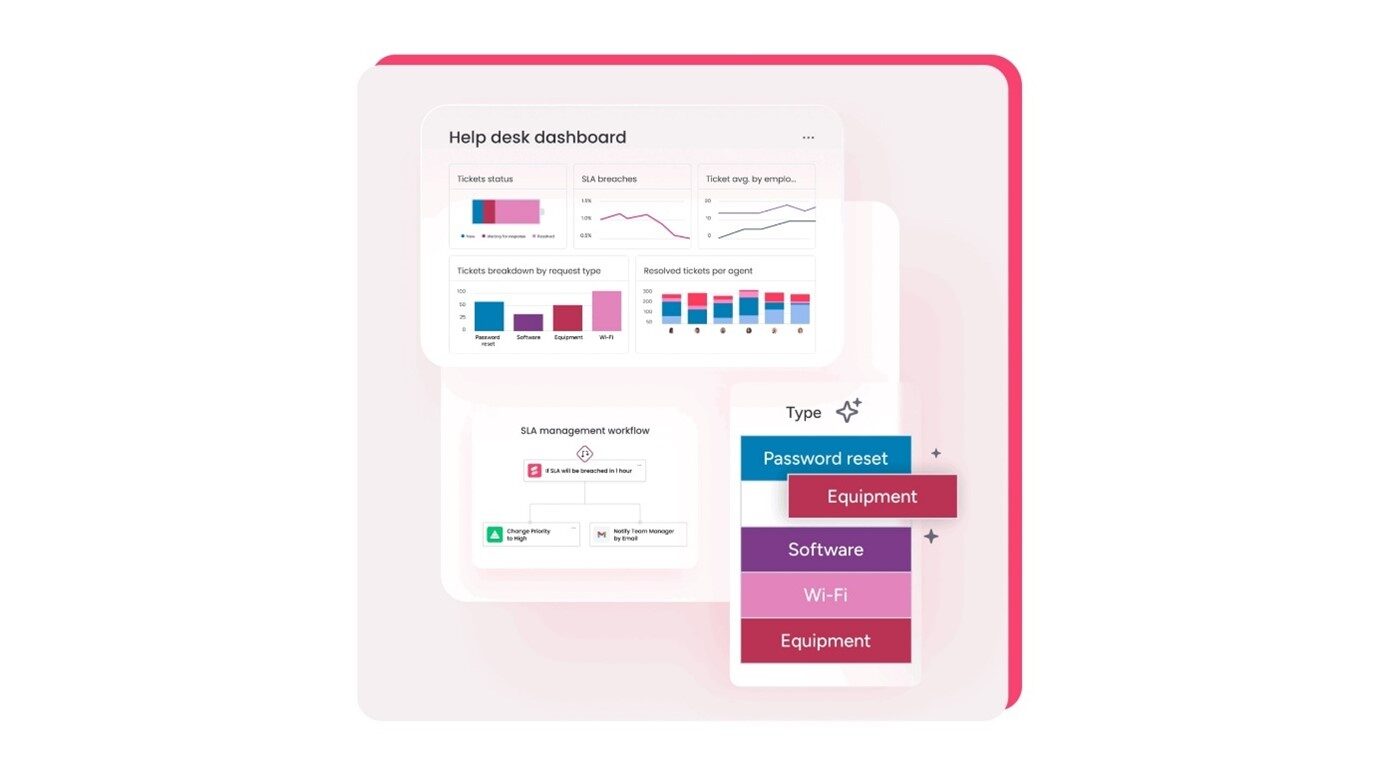
Many portals are complex to implement and difficult for employees to adopt. The monday service platform provides an intuitive, customizable platform that fits your workflows and scales with your organization.
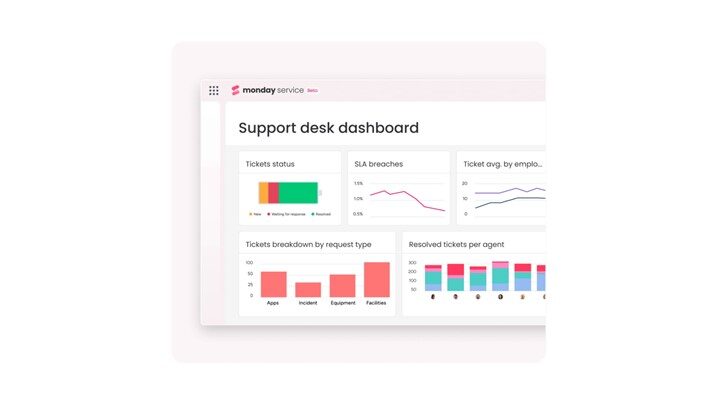
Requests, tickets, and service catalogue items live in one place. IT teams gain full visibility into every ticket and its related project milestones, ensuring issues are resolved with the broader context in mind.
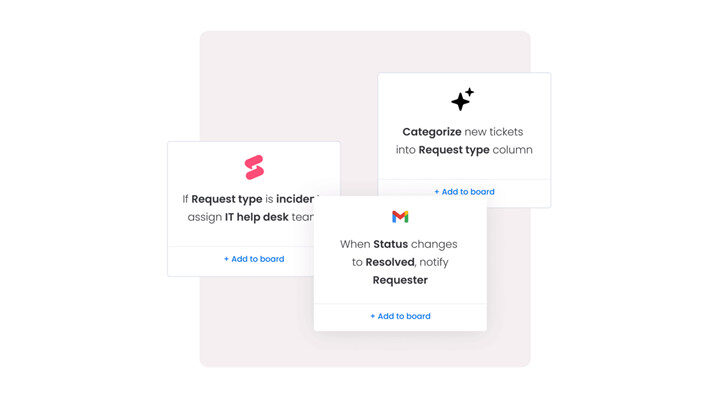
AI routes tickets to the right team, suggests next steps, and triggers CSAT surveys automatically. Automations close resolved tickets, send updates, and escalate urgent issues to keep work moving.
Unlike traditional ITSM (IT service management) tools that stop at routing, monday service AI learns from past tickets and employee behavior. It recommends next-best actions, predicts recurring issues, and surfaces relevant knowledge base content proactively — helping teams prevent problems before they escalate.
Every organization has different needs. The flexibility of monday service makes it easy to brand your portal, configure request forms, and adjust approval paths without developer support. As needs change, workflows can be updated in minutes.
Service requests often involve HR, finance, or operations management. Collaboration is seamless with monday service, which allows teams to add approvers, share updates, and attach files directly within a ticket. Everyone stays aligned with the complete history in one place.
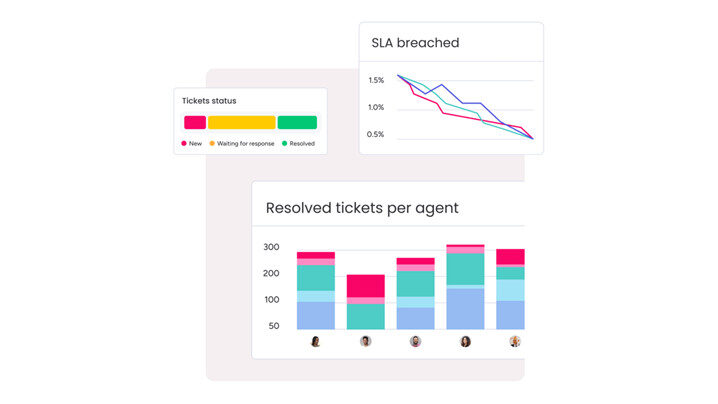
Dashboards display SLA (service level agreement) performance, ticket volumes, and recurring issues. Because service data connects with related projects, leaders can identify trends, address bottlenecks, and prevent problems before they affect the business.
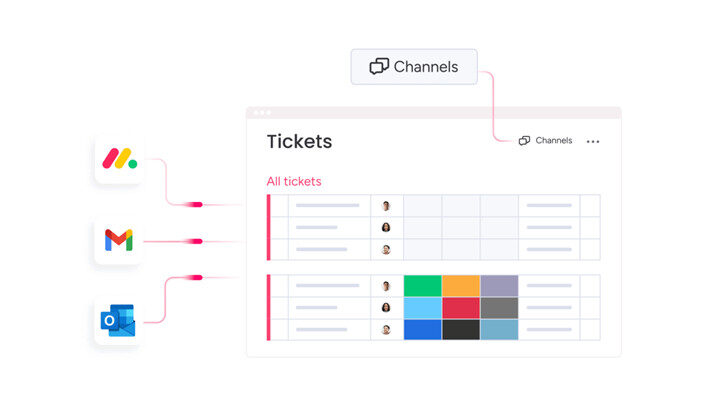
Outlook and Gmail tickets flow directly into monday service. Slack channels display live updates. Azure DevOps connects development workflows, while DocuSign brings contracts and SLAs into one system. These integrations cut context switching and improve efficiency.
Enterprise identity and governance features such as SSO/SAML, SCIM, granular roles, and audit logs are built into monday service. Data is encrypted in transit and at rest, and the platform’s architecture supports high ticket volumes and multi-department operations without sacrificing performance.
Employees can submit requests and track progress from any device. Branded domains build trust, while live chat delivers real-time support when needed. A mobile-friendly interface ensures employees get help wherever they work.
Rolling out a service portal requires clear goals, careful planning, and consistent follow-through. A structured approach ensures it delivers long-term value.
Identify the challenges your portal should address. Common objectives include cutting down on duplicate requests, improving SLA compliance, and giving employees faster access to support. Involve IT, HR, operations, and other stakeholders early to set measurable success criteria.
The value of a portal depends on the resources it offers. Create a knowledge base with troubleshooting guides, FAQs, and how-tos for common issues like password resets or access requests. Add a service catalogue with structured forms and approval paths so employees can request hardware, software, or permissions consistently.
Awareness is critical. Communicate benefits such as faster resolutions, self-service options, and request visibility across internal channels. Provide short training or quick-start guides to help employees feel confident using the portal.
Adoption challenges are common and employees may continue to email IT or hesitate to use automation. These barriers are reduced with monday service through embedded support in Slack and Outlook, plus transparent status tracking that helps employees see progress in real time.
Track performance against your goals with built-in dashboards. Monitor ticket volume, SLA compliance, and CSAT scores. Gather employee feedback to refine workflows, expand the service catalogue, and update content. The dashboards in monday service make it easy to spot trends and adjust quickly.
Successful portals evolve over time. Continuous updates and improvements keep the experience relevant and useful.
An IT service portal cuts down on duplicate requests, lowers costs, and delivers a smoother experience for employees. It also gives IT leaders the visibility they need to operate efficiently.
With monday service, you can launch a portal that’s easy to adopt, customizable to your workflows, and powered by AI. The sooner you shift to an intelligent service portal, the faster your teams can focus on strategic work and innovation.
The page you requested could not be found. Try refining your search, or use the navigation above to locate the post.

# CRM Automation, Sales Productivity, AI in Sales, Digital Transformation, Customer Experience, Future Of Work, SalesTechnology
Choosing the right product management platform is a pivotal decision for modern teams aiming to deliver exceptional products. Both Productboard and Jira offer distinct strengths tailored to different workflows and priorities.
Productboard centralizes customer feedback and aligns roadmaps, making it a favorite among product managers focused on prioritizing features. Jira, on the other hand, is renowned for its issue tracking, deep workflow customization, and scalability, making it the go-to choice for engineering and Agile development teams.
However, if your team needs a flexible, all-in-one solution that combines intuitive customization, seamless collaboration, and advanced AI capabilities, monday dev emerges as a compelling alternative.
In this guide, we’ll compare each platform’s features, integrations, pricing, support, and customer reviews so you can find the best fit for your team’s unique needs.
Try monday dev
Short on time? Here’s what you need to know about Productboard and Jira in a nutshell.
|
Criteria |
Productboard |
Jira |
|
Features |
Feedback management |
Agile boards |
|
Feature prioritization |
Workflow customization |
|
|
Customizable roadmaps |
Issue tracking |
|
|
Real-time collaboration |
Advanced reporting |
|
|
AI-powered insights via add-on |
AI-powered insights built-in |
|
|
Integrations |
18+ native integrations plus thousands more through third-party platforms like Zapier, Make, and Integrately |
3,000+ via Atlassian Marketplace, including Bitbucket, Confluence, GitHub, GitLab, and Slack |
|
Pricing |
Free plan available; premium plans from $19/maker/month |
Free plan available; premium plans from $8.60/user/month |
|
Ease of use |
Intuitive user-friendly design, but extensive feature set requires short adjustment period |
Powerful but complex with a steep learning curve especially for non-technical teams |
|
Support |
Tiered level support ranging from the online community to priority email support, depending on the pricing plan |
Tiered level support ranging from the online community to 24/7 premium support, depending on the pricing plan |
|
Ratings |
4.3/5 (250+ reviews) on G2 |
4.3/5 (6,450+ reviews) on G2 |
For a more detailed breakdown of Jira and Productboard, continue reading below.

When choosing between Productboard and Jira, understanding their core features is essential to finding the right fit for your team’s workflow. Each platform brings a different set of strengths to the table, influencing how teams plan, collaborate, and deliver projects.
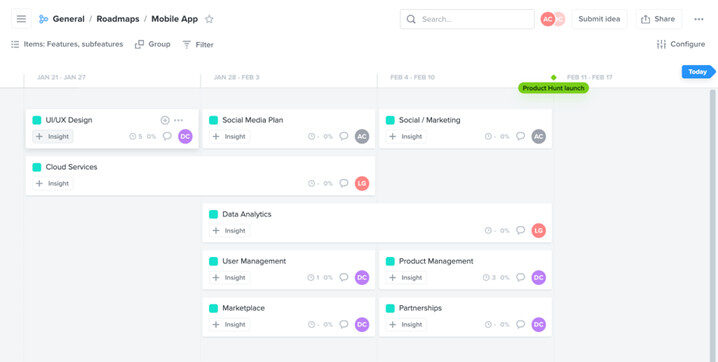
Productboard enables product teams to make informed decisions by organizing insights and aligning stakeholders around a shared vision. Its suite of tools prioritizes what to build next and ensures everyone stays focused on customer value.
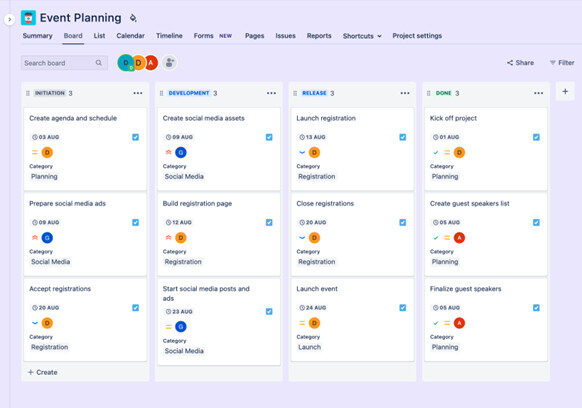
Jira allows engineering teams to manage projects at scale and adapt to evolving requirements. Its feature set supports detailed workflow management and seamless coordination across complex engineering environments.
When evaluating Productboard and Jira, integration capabilities are a key factor in supporting seamless workflows across teams and tools. Both platforms offer extensive options to connect with external systems, but their approaches and depth of integration may influence which solution best fits your organization’s needs.
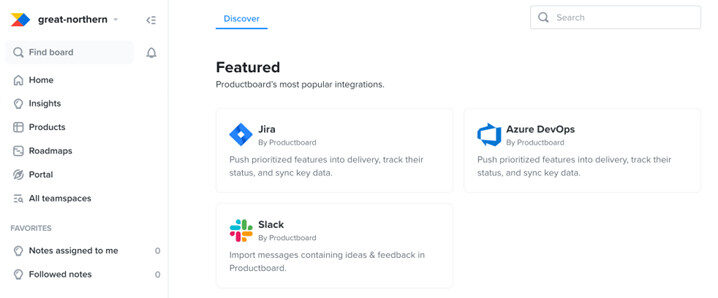
Productboard makes it easy for teams to connect with popular tools such as Jira, Azure DevOps, and Slack, supporting a unified workflow across product and development. Its open APIs and powerful two-way Jira integration enable seamless transfer of prioritized features into engineering backlogs, ensuring alignment from planning through execution.
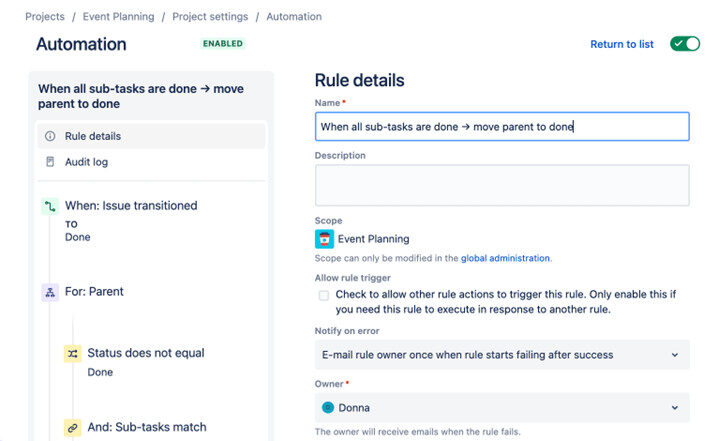
Jira offers one of the largest integration ecosystems, with thousands of available apps in its Atlassian Marketplace and native connections to tools such as Bitbucket, Opsgenie, and Confluence. Teams can automate processes and extend functionality using OpenAPI support, though advanced integrations may require additional third-party apps or administrative setup.
Pricing is a crucial factor when selecting a product management or development platform, as it impacts both your budget and the features available to your team. Both Productboard and Jira offer tiered plans to accommodate a range of business sizes, but their pricing models and included capabilities differ significantly. You can evaluate features with a free trial before committing to a paid plan.
Productboard’s pricing structure scales with your team, from a free plan for individuals to custom options for larger organizations. The platform charges per “maker” — the users who actively manage and prioritize features — while contributors and viewers are free, making it flexible for teams with varying roles. But AI features are only available via the Pulse add-on.
Jira provides a flexible, per-user pricing model with plans that cater to everyone from small teams to large enterprises. Each tier unlocks additional storage, automation, and administrative controls, allowing teams to choose the best fit for their workflow and scale as needed. Jira AI — branded as Atlassian Intelligence — is included with Premium and Enterprise packages, with plans to roll out to the Standard tier as well.
Note: Atlassian announced that in mid-2025 it will begin implementing “maximum quantity billing” for some Jira Cloud customers. This means teams may be billed based on the highest user count over a billing cycle — not just the current active users — potentially affecting how seat-based costs are calculated.
Read more about Jira’s plans and pricing.
Selecting a platform that your team can adopt quickly and use efficiently is essential for productivity and long-term success. Both Productboard and Jira offer robust capabilities, but their approaches to usability and onboarding could significantly impact your team’s experience.
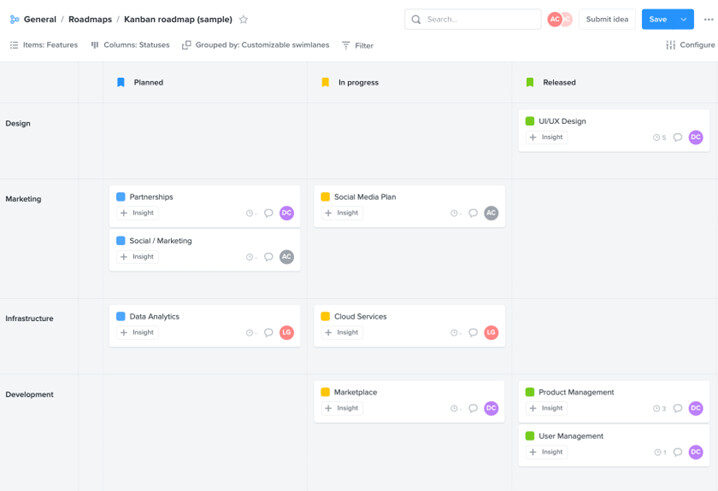
Productboard’s intuitive, user-friendly interface makes navigation and daily tasks straightforward for both technical and non-technical users. Onboarding is typically fast, though some teams may experience initial confusion due to the platform’s extensive feature set, which can require a short adjustment period.
“It’s really easy to use, and my team can implement it without extensive training. By integrating with other tools like Slack and Jira, it becomes even more integrated to our workflow.” — Denis W.
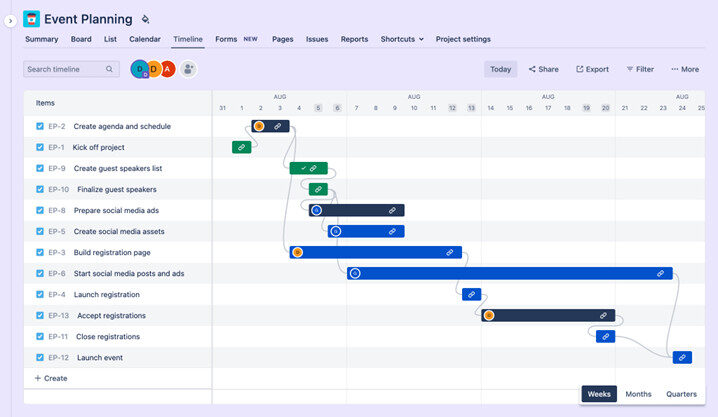
Jira provides powerful customization and workflow options, but its setup can feel overwhelming, especially for new users or teams unfamiliar with Agile tools. The platform’s steep learning curve and need for ongoing administrative support to tailor workflows and settings mean that teams often invest more time in configuration and training before reaching full productivity.
“The main issue is that it’s too complex. At first, there are so many features that it’s overwhelming. You spend a lot of time just trying to figure things out.” — Vüqar
Reliable support is vital for teams adopting new platforms, especially when troubleshooting or onboarding at scale. Productboard and Jira take different approaches to customer assistance, which can influence user satisfaction and long-term success.
Productboard offers a responsive customer support team, ensuring users receive timely help when needed. The platform also provides a comprehensive help center and onboarding resources, with tiered support available according to pricing plans:
“Productboard offers outstanding customer support. Whenever we’ve come across any issues, their team has been quick to respond with friendly and helpful assistance.” — Matthew M.
Jira includes standard support with all plans, but access to advanced assistance and faster response times typically requires an upgrade to higher-tier subscriptions. Some users have reported that support can feel slow or impersonal, particularly on basic plans, which may affect the overall experience for teams seeking hands-on guidance.
“I feel its customer support response for the complaints and issues in the app can be a bit faster.” — Spandhana E.

Understanding customer experiences with Productboard and Jira can offer valuable insight into how each platform performs in real-world scenarios. Reviews highlight the unique strengths and challenges of both tools, helping you determine which product is the best fit for your team.
Productboard receives strong praise for its ability to centralize feedback and help teams prioritize features, with many users highlighting its intuitive interface and collaborative environment. However, some reviewers note that performance can lag with larger datasets and that mastering advanced features may require a period of adjustment, particularly for new users.
“What I like most about Productboard is that it aggregates all the customer feedback in one location. This helps us more easily to determine which features to prioritize, which translates directly to our product vision. The only problem with Productboard is the fact that the software slows down when dealing with massive data sets.” — Mariusz O.
Compare:
Jira customer reviews
Users frequently commend Jira for its flexibility and the depth it brings to software development workflows, especially in environments that require robust customization and reporting. At the same time, users often point out the platform’s complexity and the ongoing need for administrative expertise, with opinions on usability ranging from highly positive to mixed depending on team experience and technical proficiency.
“What I like best about Jira is that everything goes into one place and it is easy to manage complex projects. Its capability for customizing the workflows, building out descriptive tickets, and tracking progress visually really assists with organization. What I do not like about Jira is that it is very confusing and overwhelming, especially to non-techie or novice users. There are just too many features and settings that can easily get lost or waste time figuring out how to do something instead of working.” — Pradeep S.
Compare:
Choosing between Productboard and Jira depends on your team’s primary goals, workflow preferences, and the challenges you want to solve. Both platforms are industry leaders, but they cater to different needs and excel in distinct areas.
Productboard is ideal for product managers and organizations focused on customer feedback, feature prioritization, and clear product roadmaps. Its strengths lie in centralizing insights, aligning teams, and making data-driven decisions.
Jira is best suited for software development and engineering teams that require deep workflow customization, Agile project management, and advanced reporting. It offers powerful tools for managing complex development cycles but may require more setup and ongoing administration.
|
Criteria |
Productboard |
Jira |
|
Ideal use case |
Product managers, feedback-driven organizations |
Agile engineering and dev teams |
|
Overall strengths |
Centralized feedback, feature prioritization, customizable roadmaps, team alignment |
Customizable workflows, Agile tools, vast integration ecosystem |
|
Main drawbacks |
Higher pricing at scale, some advanced features gated to higher tiers |
Steep learning curve, admin overhead, advanced features require add-ons |
To summarise:
But what if you’re looking for a platform that balances product planning, engineering execution, and user-friendly AI tools — all in one place? That’s where monday dev stands out. When you compare the G2 ratings, monday dev outperforms both Jira and Productboard in every category:
|
Criteria |
monday dev |
Productboard |
Jira |
|
Meets requirements |
9.1/10 |
8.1/10 |
8.8/10 |
|
Ease of use |
9.1/10 |
8.2/10 |
8/10 |
|
Ease of setup |
9/10 |
8.2/10 |
7.7/10 |
|
Ease of admin |
9.2/10 |
8.8/10 |
7.5/10 |
|
Quality of support |
9.1/10 |
8.9/10 |
8.3/10 |
|
Has the product been a good partner in doing business? |
9.4/10 |
8.8/10 |
8.5/10 |
|
Product direction (positive) |
9.5/10 |
8.3/10 |
8.3/10 |
|
Product management |
8.9/10 |
7.5/10 |
8.5/10 |
The right choice ultimately depends on your team’s priorities, technical needs, and long-term goals. But for teams seeking a balance of flexibility, ease of use, and advanced AI capabilities, consider exploring a flexible alternative like monday dev.
Try monday dev with The CRM Team
Built on the robust monday.com Work OS, monday dev is a frictionless, AI-powered platform that unites product and engineering teams. With effortless customization, hybrid project support, and advanced reporting all in one platform, monday dev adapts to your team’s needs.
No-code customization: Tailor Kanban or Scrum boards with custom columns, statuses, and automations, using simple drag-and-drop — no coding or admin help needed.
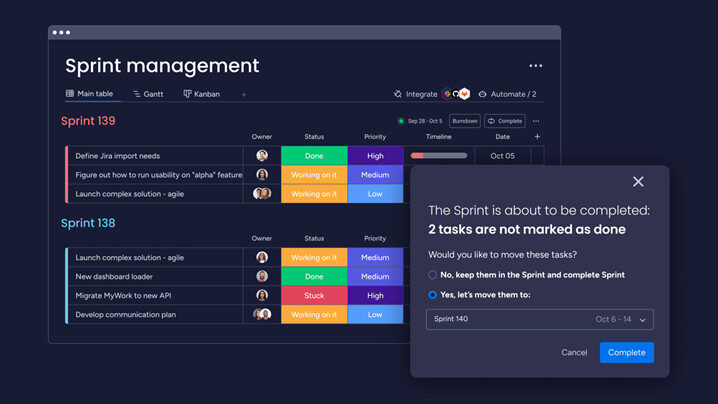
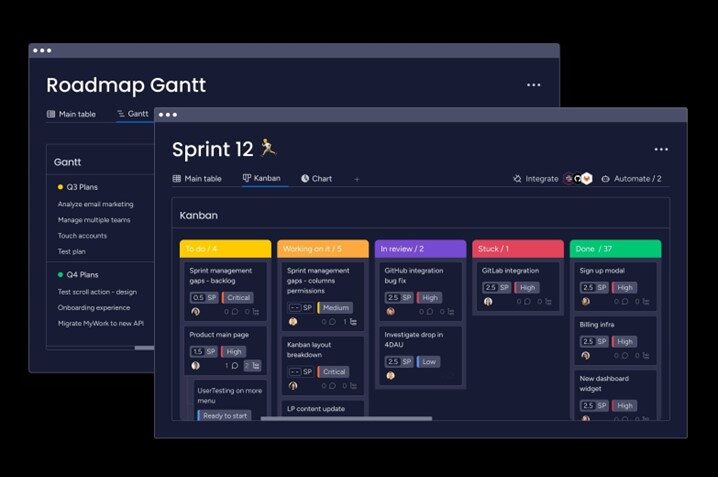
Built-in management-level reporting: Visualize different information across the organization, including Agile insights, performance dashboards, roadmap planning, and team hierarchies — no plugins needed.
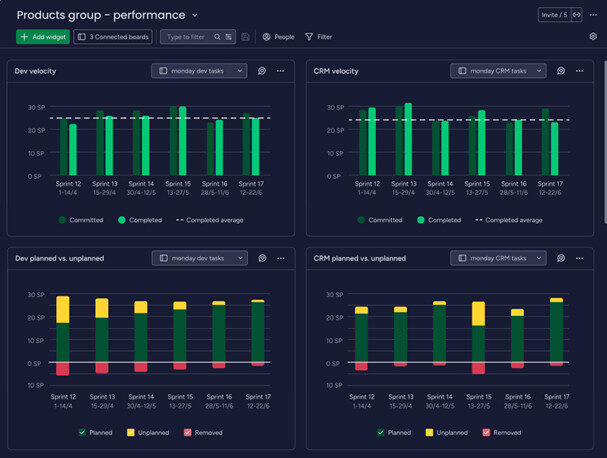
Seamless collaboration: Keep everyone aligned and informed on a single platform with workdocs, dependency tracking, and real-time updates — without switching tools.
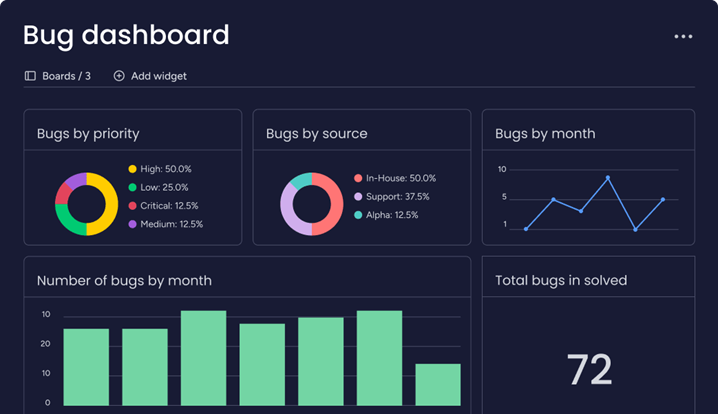
AI-powered productivity: Use ready-made AI actions to forecast velocity, identify bottlenecks, and automate routine tasks — right where you work.
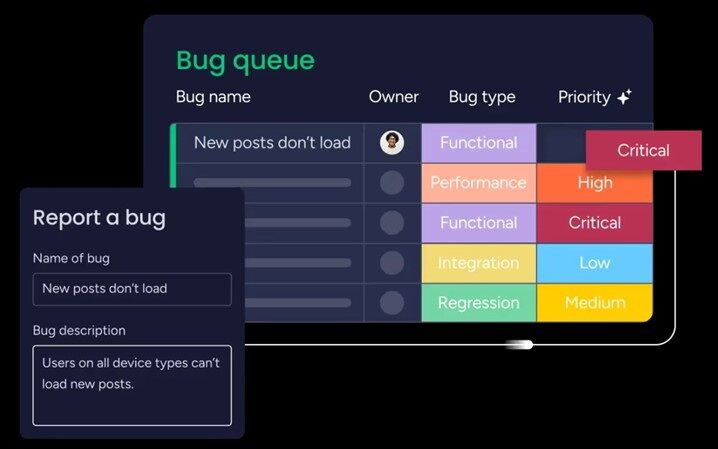
Unlike Productboard and Jira, which often require admin setup or additional apps for advanced connections, monday dev connects effortlessly with over 200 tools, including GitHub, GitLab, CircleCI, Slack, and Microsoft Teams, through a user-friendly, no-code integration hub.
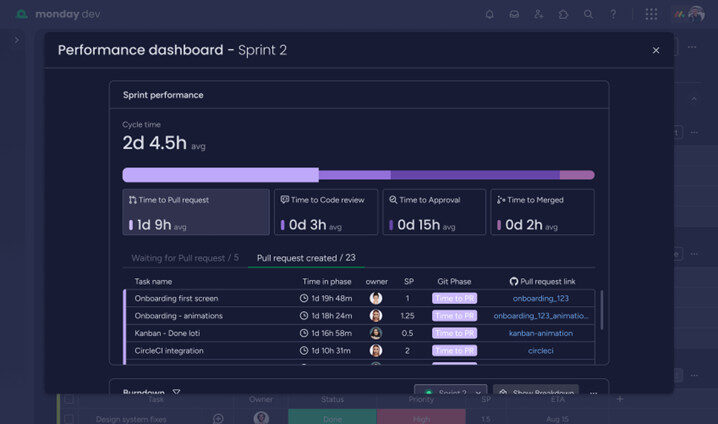
“A lot of the tools we tried were just too rigid to meet our needs. We had to connect multiple products to get the results we wanted, which created even more friction between our teams. With monday dev, everyone at luxie tech has access to the information they need to do great work.” — Mitchell Hudson.
Compared to Jira’s multiple add-ons, monday dev’s transparent and scalable pricing makes it exceptionally cost-effective for large teams seeking predictable, all-in-one value.
Read more about monday dev’s plans and pricing.
With monday dev, teams can instantly customize workflows using drag-and-drop boards, custom columns, and automations—no coding or IT support required. Its intuitive interface and ready-to-use templates make it easy for anyone to set up and adapt processes, so both technical and non-technical users enjoy a seamless onboarding experience and can start collaborating right away.
“The other systems we explored were rigid and lacked the ability to nest and marry items together. They were also so complex that it would also require a full-time administrator to run. We loved that anyone on the team could easily get up to speed with monday dev.” — Steven Hamrell.
With monday dev, every customer receives fast, friendly 24/7 support from real people on every plan. In addition to responsive phone, email, and live chat, customers benefit from a comprehensive resource library — including a community forum, self-serve knowledge base, video tutorials, daily live webinars, and dedicated customer success managers for enterprise accounts — making support highly rated for both responsiveness and helpfulness.
Trusted by over 245,000 customers, monday dev earns consistently high marks from users for its intuitive interface, flexibility, and responsive support. Teams praise the platform for letting them tailor workflows to their unique needs, empowering them to work their way rather than forcing them into rigid processes.
“The user-friendly interface of monday dev makes project monitoring and planning very simple. Our team may customize the boards and workflows of the platform to meet our unique requirements. Collaboration is facilitated by integration with GitHub and Slack, and the automation capabilities let us save a ton of time on tedious work. Furthermore, the analytics and reporting tools enable us to continuously improve our procedures and offer insightful information about the status of our project.” — Siddarth N.
Ready to experience a better way to manage product development? The CRM Team and see how your team can move faster, collaborate better, and deliver more value on one flexible platform.
The page you requested could not be found. Try refining your search, or use the navigation above to locate the post.

# CRM Automation, Sales Productivity, AI in Sales, Digital Transformation, Customer Experience, Future Of Work, SalesTechnology
CRM Agent Technology: Top AI Solutions & Benefits for 2025
Sales teams are designed to close deals, but too often get bogged down with repetitive admin like manually qualifying leads, entering data, and trying to keep up with follow-ups. This slows response times and lets opportunities slip through the cracks, especially as only 51% of sales professionals currently use AI to help lighten the load.
CRM agents change that equation. These AI-powered digital workers automate lead qualification, customer communication, and data management, working 24/7 to free your team for higher-value selling. In this guide, you’ll see the key benefits of CRM agent technology, the features that matter most, and practical steps to measure their impact on sales productivity and success.
CRM agents are AI-powered digital workers that handle customer relationship tasks without human help. Think of them as an AI sales agent that can qualify leads, answer customer questions, and manage follow-ups automatically.
Unlike regular CRM software where you manually enter data and track interactions, a CRM with AI can make decisions on its own. They learn from your customer data and get smarter over time.
AI transforms your CRM from a digital filing cabinet into an active team member. Here’s how the technology works in simple terms:
These technologies work together to handle complex processes that used to require human judgment, making sales automation more intuitive than ever.
You might wonder: aren’t CRM agents just fancy chatbots? Not quite. While chatbots answer questions with pre-written scripts, CRM agents manage entire customer relationships in advanced CRM software solutions.
Every CRM agent needs four key parts to work effectively. Understanding these helps you see how agents can fit into your business:
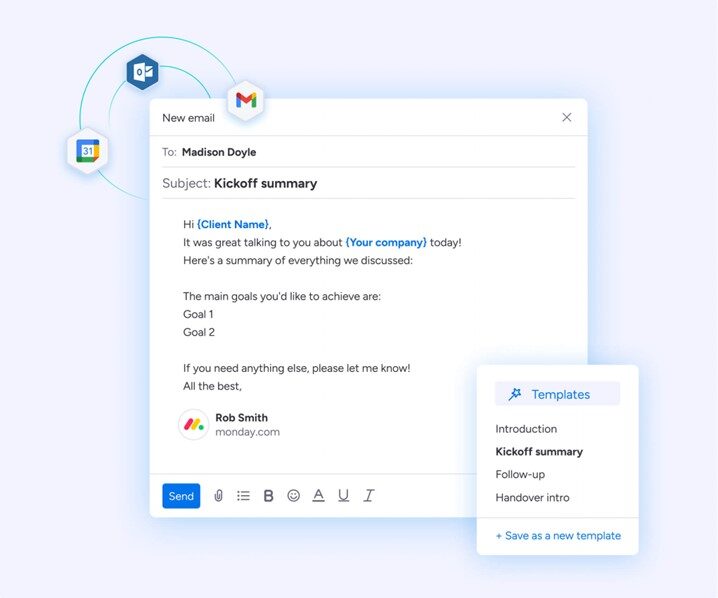
If you’re using a traditional CRM, you might wonder whether switching to an agent-powered system is worth it. Here’s what changes when you make the move.
Traditional CRMs often take months to set up properly. You need to configure fields, build workflows, and train your team on complex processes.
CRM agents start delivering value much faster. They learn from your existing data and adapt to your processes rather than forcing you to change. Many businesses see results within weeks, not months.
Traditional CRM automation follows rigid rules: “If this, then that.” These rules work until something unexpected happens, which is often.
CRM agents use intelligent automation that adapts to each situation. They consider context, learn from outcomes, and make decisions more like a human would. This flexibility means fewer errors and less manual intervention.
Your traditional CRM is the same today as it was last year unless you manually updated it. CRM agents get smarter every day through machine learning.
They notice which email templates get the best response rates and use them more often. They learn which lead sources produce the best customers and adjust scoring accordingly. This continuous improvement happens automatically.
CRM agents might cost more upfront than traditional systems, but they deliver ROI faster through reduced labor costs, higher conversion rates, better retention, and faster scaling.
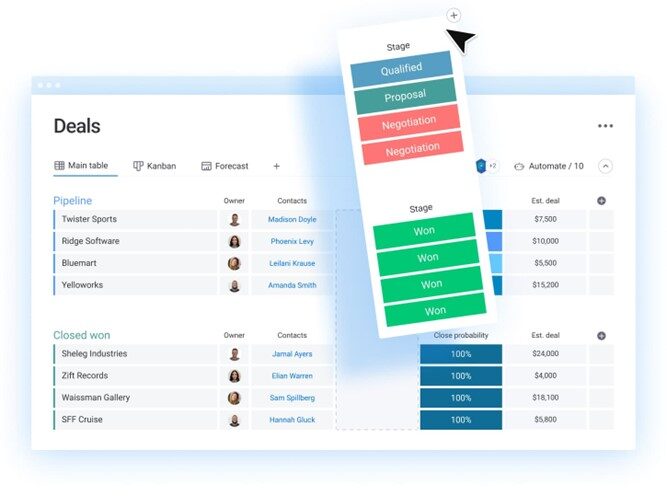
CRM agents do more than save time — they fundamentally change how you can grow your business by leveraging AI for sales prospecting and automated processes. Let’s look at the specific ways they help revenue teams succeed.
Your customers don’t stop needing help when you leave the office. CRM agents work around the clock, qualifying leads from different time zones and answering customer questions on weekends.
Imagine a prospect in Australia visits your website while you’re asleep. The agent can qualify them, schedule a meeting for your morning, and send them relevant information — all before you wake up, similar to a CRM for call center approach that never misses a call.
How much time does your team spend figuring out which leads to pursue? CRM agents analyze every interaction to score leads automatically.
They look at website behavior, email engagement, and company information to identify your hottest prospects, pairing these insights with sales tech to streamline your pipeline. Your sales team gets a prioritized list each morning, so they know exactly who to call first.
CRM agents spot opportunities you might miss. They analyze customer patterns to predict who’s likely to buy, who might cancel, and when to reach out for maximum impact, especially when leveraging AI in B2B sales.
For example, if a customer’s usage drops suddenly, the agent alerts you before they consider switching to a competitor. This proactive approach helps you save deals before they’re lost.
Growing companies face a challenge: how do you handle more customers without hiring proportionally more staff? CRM agents solve this by handling increasing workloads automatically.
Whether you have 100 or 10,000 customers, agents manage routine tasks at the same high quality. This advantage is particularly relevant for CRM for insurance agents who handle large client portfolios. This lets your human team focus on strategic work while agents handle the volume.
Nobody became a salesperson to type notes all day, yet according to HubSpot, sellers in the US and Canada spend over one-third of their time on administrative duties and updating their CRM. CRM agents capture information from emails, calls, and meetings automatically, aligning perfectly with CRM automation best practices.
They update contact records, log activities, and maintain accurate data without anyone lifting a finger. Your team spends time selling, not typing.
Every customer wants to feel special, but personalizing thousands of interactions seems impossible. CRM agents make it happen by tailoring every message to individual preferences and history.
They remember past purchases, communication preferences, and specific needs by using customer data analysis to deliver relevant recommendations that feel personal. Each customer gets relevant recommendations and timely follow-ups that feel personal because they are.
When agents handle routine work, your team can focus on what humans do best — building relationships and solving complex problems. Sales reps arrive at meetings fully prepared with talking points and customer insights provided by the agent.
Sales and support teams face constant pressure to do more with less: faster outreach, more meaningful customer touch points, and seamless collaboration. But with limited time and resources, scaling up often means sacrificing quality or burning out your best people. That’s where CRM agents come in.
These intelligent digital partners don’t just automate tasks — they fundamentally change how you connect with customers and drive growth, freeing your team to focus on high-impact work while elevating every interaction. Here’s how CRM agents reshape the day-to-day for both sales and service.
Your SDR team probably spends hours on repetitive tasks like initial outreach and meeting scheduling. CRM agents take over these processes while maintaining quality.
The agent identifies interested prospects, sends personalized first messages, and books meetings directly into calendars. When prospects respond, it knows whether to continue the conversation or hand off to a human.
monday CRM makes this even easier with AI Blocks that categorize leads instantly and extract key information from any communication. Your team sees exactly what matters without reading through long email threads.
Support tickets pile up fast, especially for growing companies. CRM agents handle common questions instantly while routing complex issues to the right specialists.
They don’t just match keywords — they understand context. If a customer mentions they’re “having trouble with the new update,” the agent knows their account history, what version they’re using, and whether similar issues have been resolved before.
Driving proactive engagement to prevent churn
Waiting for customers to tell you they’re unhappy usually means waiting too long. CRM agents monitor usage patterns and engagement levels to spot problems early.
When a customer’s activity drops or their renewal date approaches, the agent triggers appropriate outreach. It might send helpful resources, schedule a check-in call, or offer incentives — whatever has worked for similar customers in the past.
Sales managers need to know what’s working and what isn’t. CRM agents provide continuous analysis of team performance, deal progress, and pipeline health.
Instead of waiting for monthly reports, you get daily insights about which reps need coaching, which deals are stuck, and what actions could improve results. The agent even suggests specific next steps based on successful patterns.
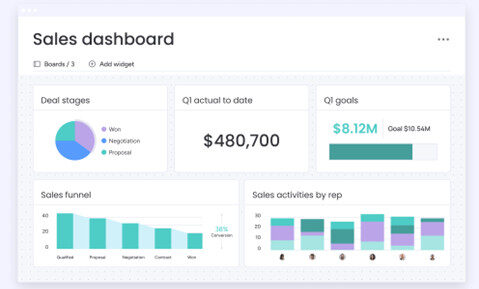
Not all CRM agent platforms are equal. Here are the must-have features that separate powerful agents from basic automation.
Your CRM agent needs to understand human communication, not just process keywords. Good NLP means the agent can:
Customers contact you through email, phone, chat, and social media. Your CRM agent should work across all these channels seamlessly.
This means maintaining conversation context when someone emails after calling, or when they message on social media about an email they sent. The agent keeps everything connected so customers never have to repeat themselves.
Speed matters in sales and service. CRM agents need to process information instantly to provide relevant responses and recommendations.
When a high-value prospect visits your pricing page, the agent should alert sales immediately. When a customer’s credit card fails, it should trigger retention protocols right away.
Your business is unique, and your CRM agent should adapt to your specific processes. Look for platforms that let you configure agent behavior without coding.
You should be able to set rules for lead routing, define escalation triggers, and customize communication templates. The best platforms make this as simple as dragging and dropping.
Customer data is sensitive, and CRM agents handle a lot of it. Essential security features include:
Different industries use CRM agents in unique ways. These examples show how agent technology adapts to various business needs.
Healthcare providers use CRM agents to manage patient relationships while maintaining strict privacy standards. Agents handle appointment reminders, medication refill notices, and follow-up care coordination.
They can identify patients who miss appointments and automatically reschedule, or flag those who might need extra support based on their interaction patterns. All while maintaining HIPAA compliance.
Banks and investment firms face complex regulatory requirements. CRM agents help by monitoring all client communications for compliance issues and automatically generating required documentation.
When advisors talk to clients, agents provide real-time guidance about what they can and cannot say. They also track all interactions for audit purposes and flag potential violations before they become problems.
Retail CRM agents analyze purchase history and browsing behavior to create personalized shopping experiences. They send targeted product recommendations, recover abandoned carts, and coordinate inventory with demand.
During peak seasons, agents handle the surge in customer inquiries while maintaining personalization. They know which customers prefer email versus text, who responds to discounts, and when to reach out for maximum impact.
B2B sales cycles involve multiple stakeholders and long decision processes. CRM agents track every interaction across the buying committee, identifying champions and blockers.
They provide sales reps with talking points for each stakeholder, suggest next steps based on similar successful deals, and alert managers when deals need attention. This orchestration keeps complex sales moving forward.
Consulting firms and agencies use CRM agents to manage client communications throughout long projects. Agents send progress updates, coordinate feedback rounds, and ensure nothing falls through the cracks.
They can detect scope creep by analyzing communication patterns and alert project managers before budgets are impacted. This proactive management keeps projects profitable and clients happy.
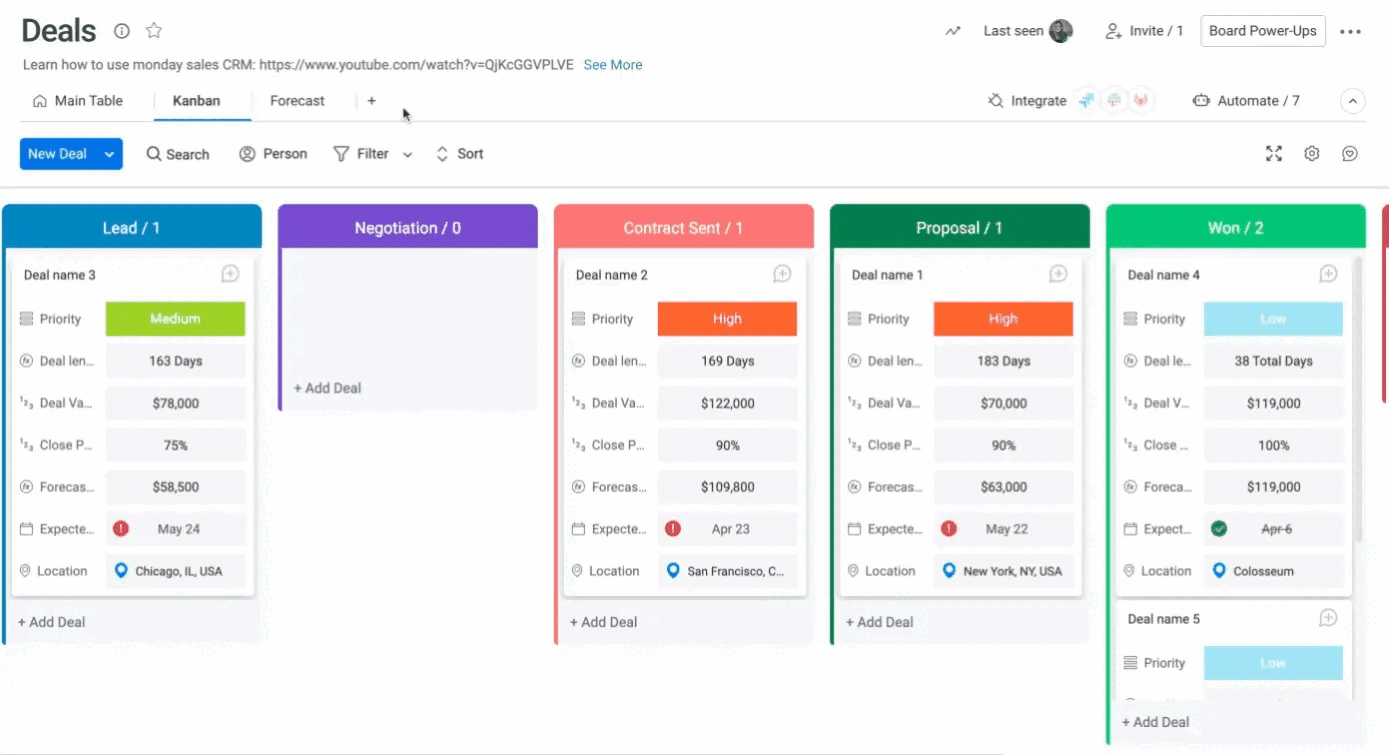
With agent technology built into your CRM, teams of any size or technical skill level can completely transform how they work. These intelligent features are designed for real people, making AI-powered workflows intuitive and accessible, even for small businesses that don’t have in-house IT support. Personalised value and automation are now within reach for everyone.
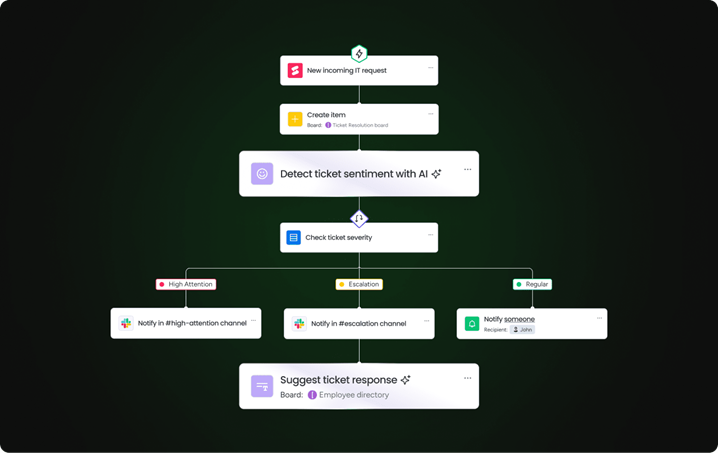
AI Blocks work like building blocks for automation. You don’t need to understand AI to use them — just click to add capabilities like:
These blocks work together to create sophisticated workflows. For example, combine Extract Info with Categorize to automatically process incoming leads and route them to the right sales rep.
Building CRM agents in monday CRM requires zero coding knowledge. The visual interface lets you drag and drop to create agent workflows that match your exact needs.
You can adjust agent behavior anytime as your business evolves. Need to change lead scoring criteria? Update it in minutes. Want to add a new automation? Just drag in a new block.
Do monday CRM agents work in isolation? No! They connect with your entire organization through the monday.com Work OS, sharing insights and triggering actions across departments.
When an agent identifies an upsell opportunity, it can notify sales, update the product team about feature requests, and alert customer success to provide extra support. This coordination happens automatically, keeping everyone aligned.

Ready to add CRM agents to your business? Here’s a practical, step-by-step roadmap to get started:
Start by examining what you have now. Look at your data quality, system integrations, and current workflows to identify where agents can help most.
Check these areas:
Decide exactly what you want agents to do. Start with simple, high-volume tasks before moving to complex processes.
Map out each agent workflow in detail. For example, for lead qualification:
Your team might worry that agents will replace them. Address these concerns directly by showing how agents make their jobs easier, not obsolete. In fact, monday.com’s world of Work report found that 60% of employees believe improved training is key to navigating workplace transitions.
Provide training on:
Launch your CRM agents with clear success metrics. Track performance weekly and adjust as needed.
Key metrics to monitor:
You need to prove that CRM agents deliver real value — not just in theory, but in day-to-day results that matter to your business. That means going beyond gut feel or anecdotal wins and actually tracking how agent-driven automation impacts your bottom line, team productivity, and customer satisfaction.
Here’s how to measure their impact on your business:
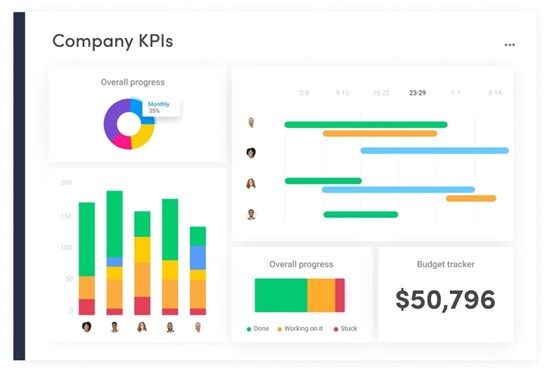
Focus on metrics that directly connect to revenue and efficiency. Track these KPIs to demonstrate agent value:
Happy customers are the ultimate success metric. Measure satisfaction through:
Calculate the real hours your team saves with CRM agents. Track time spent on manual data entry before and after agents; lead qualification and scoring; meeting scheduling and follow-ups; and report generation and analysis. Then, convert these time savings into dollar values to show concrete ROI.
AI-powered CRM agents aren’t just the next step in sales and customer service—they’re a leap forward. By automating routine tasks, delivering personalized experiences at scale, and providing real-time insights, these digital workers empower your team to focus on building relationships and driving results.
The businesses that embrace CRM agent technology today will be tomorrow’s leaders, equipped to adapt, innovate, and grow in a rapidly changing landscape. Ready to see what’s possible? The time to transform your workflow — and your customer experience — is now.
AI-powered CRM agents aren’t just the next step in sales and customer service—they’re a leap forward. By automating routine tasks, delivering personalised experiences at scale, and providing real-time insights, these digital workers empower your team to focus on building relationships and driving results.
The businesses that embrace CRM agent technology today will be tomorrow’s leaders, equipped to adapt, innovate, and grow in a rapidly changing landscape. Ready to see what’s possible? The time to transform your workflow — and your customer experience — is now.
The page you requested could not be found. Try refining your search, or use the navigation above to locate the post.

At The CRM Team, we understand how vital it is to connect the dots across customer interactions. That is why we are excited about the transformative impact of Dynamics 365 Customer Insights, a platform that allows businesses to gather, analyse, and act on customer data like never before. By integrating data from multiple sources into a single, unified view, Dynamics 365 Customer Insights empowers companies to create more personalized marketing strategies.
Here is how it is revolutionizing the business landscape.
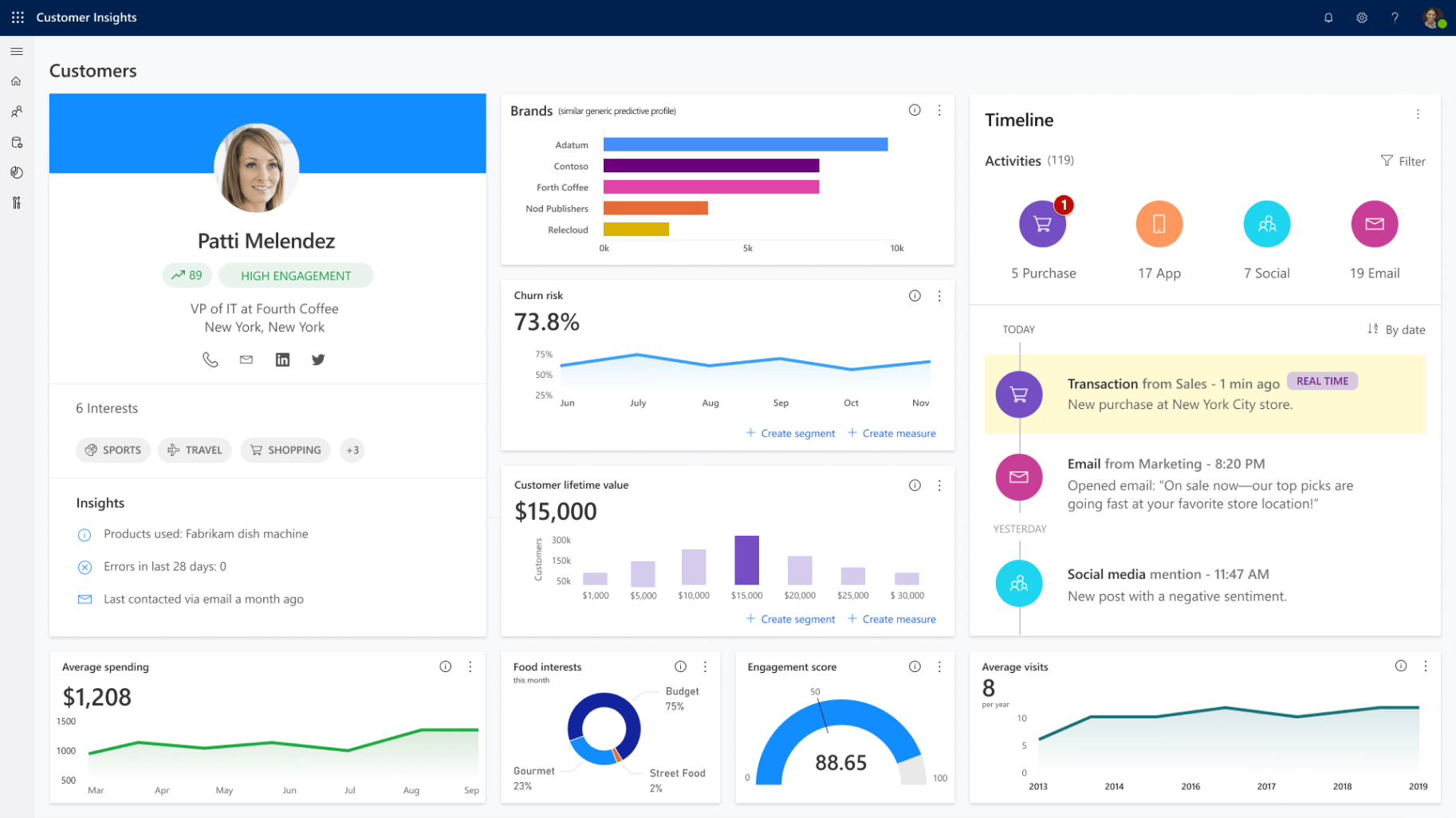
One of the biggest challenges businesses faces is fragmented data. Customer information is often scattered across various systems—CRM, email marketing platforms, e-commerce sites, and social media channels, to name a few. This fragmentation makes it difficult to get a holistic view of each customer.
Dynamics 365 Customer Insights solves this problem by pulling data from multiple sources and centralizing it in one place. Whether it is transactional data, behavioural data, or demographic information, the platform unifies everything, giving businesses a complete 360-degree view of each customer. This unified data allows companies to better understand customer preferences, purchase behaviour, and engagement patterns.
For more information on how to improve customer data management, check out Microsoft’s detailed guide on customer relationship management (CRM).
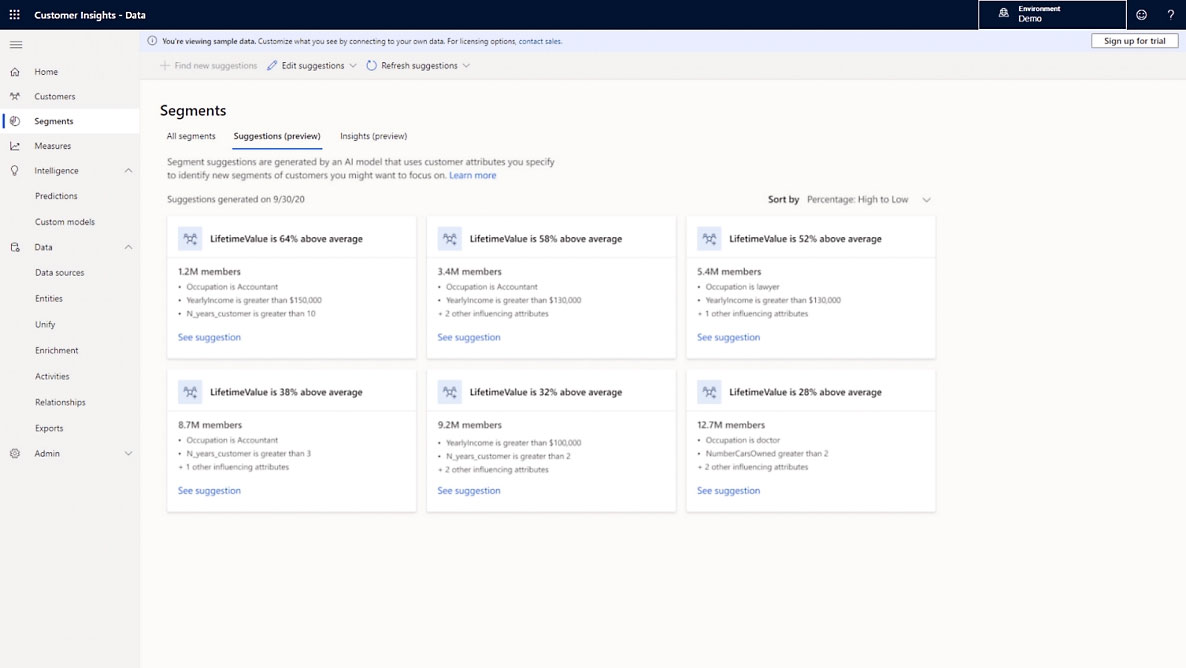
Having data is one thing but turning that data into actionable insights is where the real power lies. Dynamics 365 Customer Insights uses AI and machine learning to analyse customer data and generate predictions that can help businesses make informed decisions.
For example, the platform can predict which customers are most likely to churn, allowing businesses to proactively address potential issues. It can also identify the best time to reach out to a customer or recommend the most relevant products based on previous behaviours. With these insights at their fingertips, businesses can personalize their marketing efforts and improve customer experiences in a way that resonates with their audience.
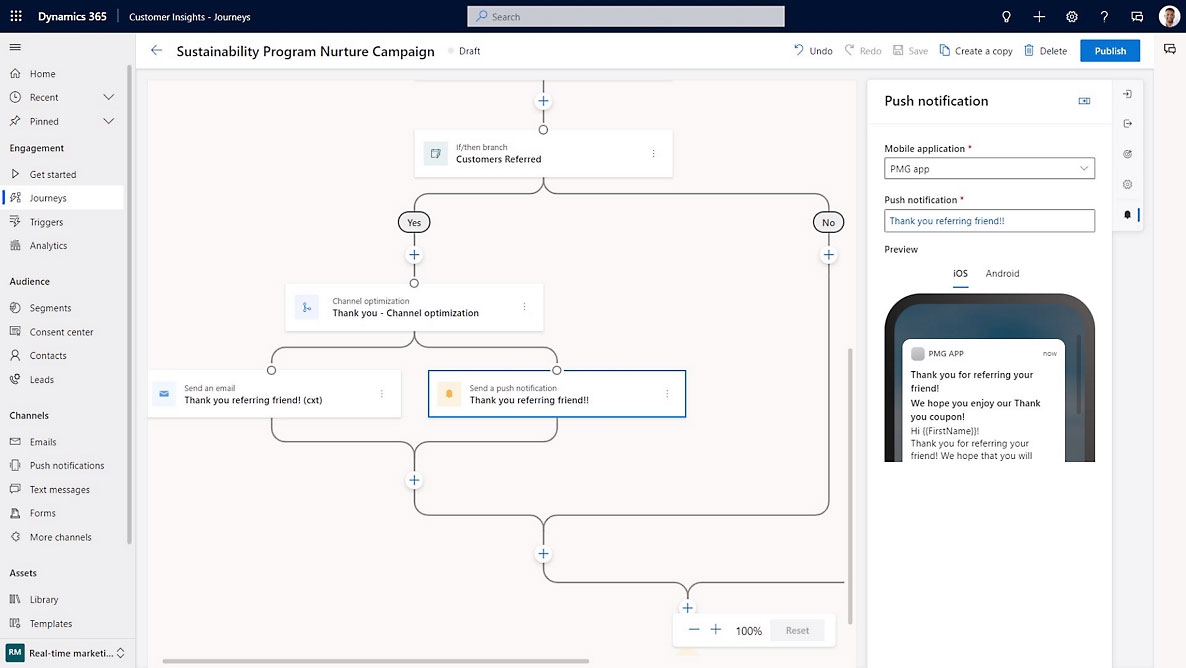
Customers today expect personalized experiences. 80% of customers are more likely to purchase from a company that offers personalized experiences. With Dynamics 365 Customer Insights, businesses can tailor their marketing efforts to individual customers, ensuring that each interaction is relevant and timely.
By using the platform’s predictive insights, businesses can send personalized product recommendations, tailored email campaigns, and targeted offers. This level of personalization not only enhances customer satisfaction but also increases loyalty and drives repeat business.
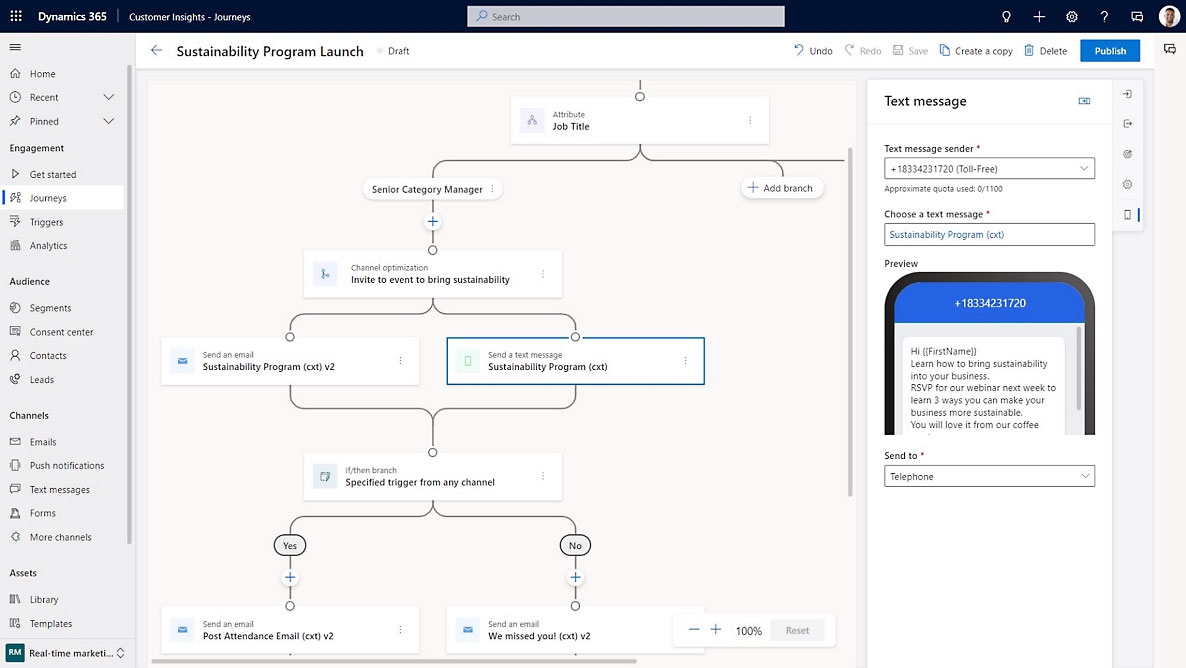
A data-driven marketing strategy is no longer a luxury, it is a necessity. Dynamics 365 Customer Insights enables businesses to build marketing campaigns based on data-driven insights, ensuring that every message, offer, and interaction is backed by real customer information.
With this powerful tool, businesses can segment their audiences more effectively, optimize customer journeys, and deliver the right message at the right time. Whether you are looking to drive customer acquisition, increase retention, or boost engagement, Dynamics 365 Customer Insights gives you the data-driven foundation you need to succeed.
At The CRM Team, we know that the power of customer data is clear, but unlocking its full potential requires the right tools. Dynamics 365 Customer Insights offers businesses the ability to utterly understand their customers, predict their needs, and create personalized experiences that drive loyalty and growth.
Dynamics 365 Customer Insights is the answer you have been seeking if you are prepared to leverage customer data and elevate your marketing strategy.
To learn more about how this powerful platform can transform your business, contact us for more information.

The page you requested could not be found. Try refining your search, or use the navigation above to locate the post.

The sales sector is advancing at an unprecedented pace, driven by technological progress and evolving consumer preferences. As businesses strive to stay competitive, they must adapt their sales strategies to meet the demands of the digital age.
Artificial Intelligence, coupled with Microsoft Dynamics 365, is transforming the operations of sales professionals. They aid in customer engagement, enhance sales management, and boost revenue.
AI and Microsoft Dynamics 365 are changing the way sales professionals operate. They assist in captivating clients and handling sales more efficiently, resulting in enhanced earnings.
At The CRM Team, we assist businesses in effectively utilising these tools. Our goal is to improve sales processes, drive growth, and enhance customer experiences.
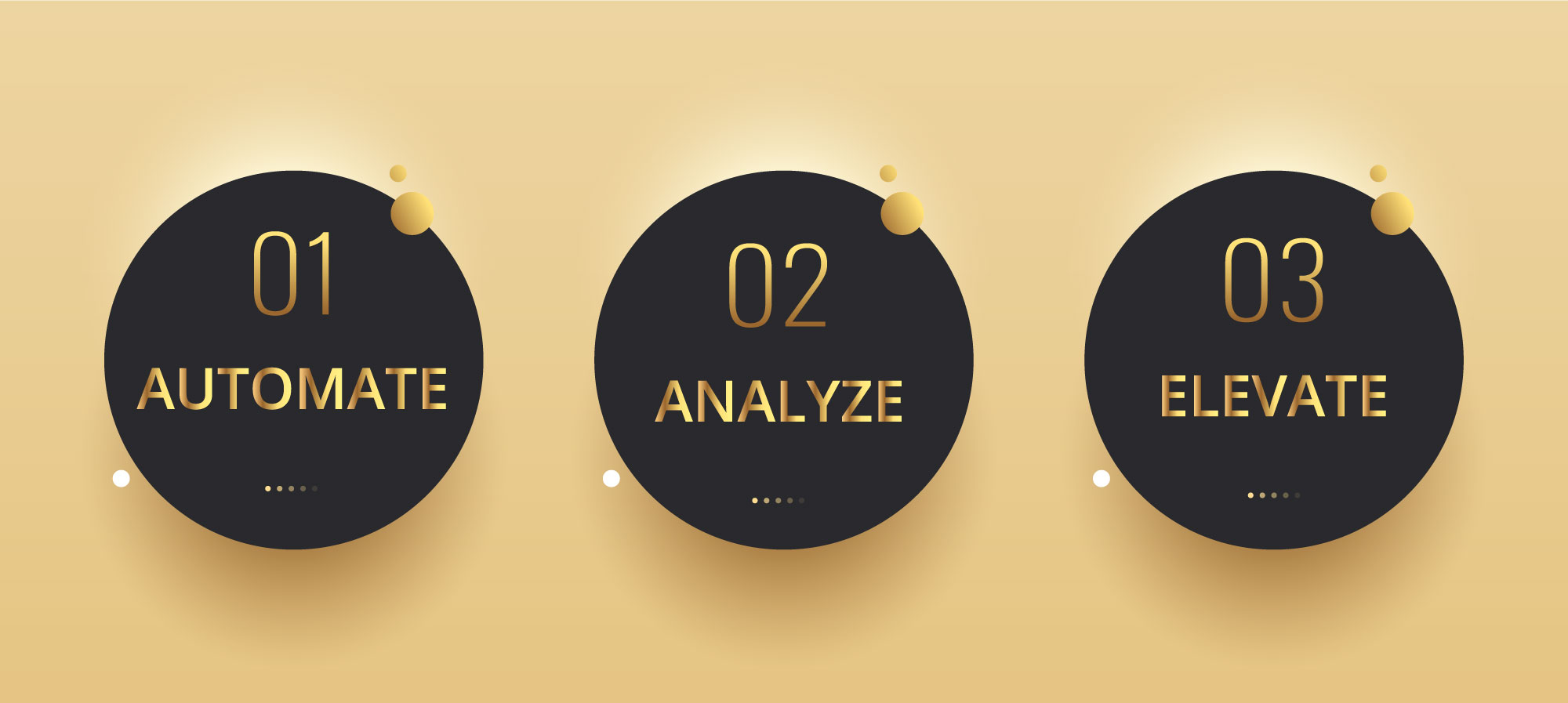
AI is changing sales by automating tasks, analyzing customer data, and giving insights for better decisions. Sales professionals will spend less time on paperwork and more time on important customer-focused tasks. AI assists sales teams in better connecting with potential customers and existing clients by analyzing data in real time. This assists them in sealing agreements and establishing robust connections.
AI in sales uses predictive analytics to predict sales trends, find potential leads, and understand customer needs. It aids businesses in enhancing their decision-making processes.
AI can study buying habits and online behaviour data to predict what products or services customers like. This enables sales teams to personalize their outreach, delivering tailored offers and recommendations that increase the likelihood of conversion.
Artificial intelligence is pivotal in lead scoring, assisting sales teams in focusing on potential deals for closure. It assists sales teams by evaluating leads through criteria such as engagement history and purchase intent. Consequently, teams can concentrate on prospects with higher value, optimizing time and enhancing their likelihood of success. This streamlines the sales process and enables businesses to engage with the right customers at the opportune moment.
AI assists sales management by automating various tasks such as data entry, follow-ups, and scheduling sales calls. This automation ultimately leads to increased efficiency in the sales process. This automation not only saves time but also minimizes errors, enabling sales professionals to focus on profit-enhancing activities. AI handles tough tasks, allowing sales teams to focus more on building strong customer relationships and increasing sales.

Image by Alissaa
In the competitive landscape of today’s market, personalization stands out as a crucial factor. Artificial Intelligence (AI) is empowering businesses to offer personalized experiences that truly connect with their prospective customers.
AI assists sales teams by examining customer data such as purchases and contact information. It offers understanding to customize communication and strategy. Such personalized strategies not only improve customer satisfaction but also foster loyalty and boost conversion rates.
Personalizing the customer experience involves understanding the unique preferences of each customer. This means offering the right products or services and delivering the correct message at the best time.
AI tools aid salespeople in developing a more profound comprehension of their customers. They are capable of predicting potential purchase opportunities for customers.
Moreover, these tools uncover customer inclinations towards particular promotions. They also empower sales representatives to interact with customers genuinely and individually. By leveraging AI to craft personalized experiences, businesses can convert potential clients into loyal customers and promote continuous expansion.
Artificial Intelligence can analyze a customer’s previous engagements with a brand, encompassing their browsing habits and purchasing history. This information can be leveraged to develop tailored marketing initiatives. Personalizing these campaigns to align with the distinct tastes of each customer increases the likelihood of a successful transaction. By delivering personalized experiences at every touchpoint, businesses can create stronger connections with their customers and enhance their overall brand experience.

Microsoft Dynamics 365 is leading the charge in the revolutionary harnessing of AI to transform and enhance sales processes. This powerful platform seamlessly integrates essential AI-driven tools, effectively optimizing the entire sales cycle. By harnessing the capabilities of AI, Microsoft Dynamics 365 empowers sales professionals to elevate customer relationships, drive sales growth, and enhance overall productivity.
Sales teams utilizing Dynamics 365 benefit from comprehensive, real-time access to customer data. This includes essential details like contact information, purchase history, and records of previous interactions. This unified view equips sales professionals to tailor personalized sales strategies according to specific customer needs and preferences, ultimately elevating the overall customer experience.
Microsoft Dynamics 365 helps sales teams by giving them up-to-date information and tools to analyze data, allowing them to make fast and informed choices.
Sales professionals can preserve their competitive advantage by monitoring performance metrics, understanding customer trends, and improving forecasting accuracy.
This helps them improve sales strategies, find new opportunities, and use data to make decisions that lead to growth and profits.
Microsoft Dynamics 365 makes it easier for sales managers to do their job by doing tasks automatically. It also works well with popular tools such as Outlook, Teams, and Power BI.
This not only enhances collaboration and teamwork, but also ensures that sales teams have the essential resources to thrive. Beyond managing customer information, Dynamics 365 amplifies customer engagement by offering a suite of tools to deliver exceptional service at every stage of the customer journey, providing tailored experiences and streamlined processes.
Businesses employing Microsoft Dynamics 365 and AI can boost their sales by automating operations, aggregating client data from diverse sources, and refining lead scoring and data evaluation.
The future of sales success lies in embracing AI and unlocking the full potential of Microsoft Dynamics 365 to create compelling, personalized experiences for customers, unearth new opportunities, and drive sustained growth and competitive edge.
The CRM Team is dedicated to helping businesses use AI to improve how they interact with customers, increase sales, and make more money. Businesses can use AI and Microsoft Dynamics 365 together to grow and succeed in today’s changing sales world. We stand prepared to help enterprises refresh their sales tactics and thrive in this contemporary age.

Yolani Williams is the marketing assistant manager at The CRM Team. Yolani holds a qualification in Strategic Corporate Communication from the University of Johannesburg and has 4 years of relevant experience in the marketing field.
The page you requested could not be found. Try refining your search, or use the navigation above to locate the post.